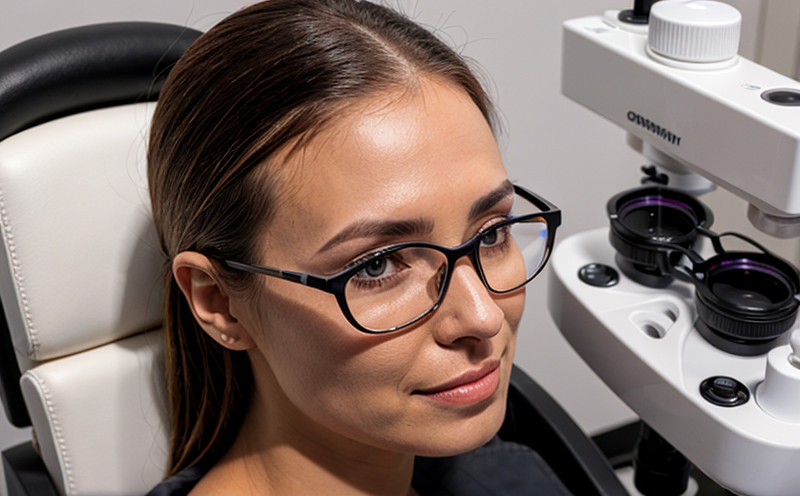USP Sterility Testing of Ophthalmic Products
The USP Sterility Testing procedure is a critical quality assurance process designed to ensure that ophthalmic products are free from any microbial or fungal contamination. This testing is particularly vital in the pharmaceutical sector, where even trace amounts of microorganisms can pose significant risks to patients undergoing ocular surgeries or suffering from ocular infections.
The United States Pharmacopeia (USP) is a compendium that sets standards for drug ingredients and finished products. USP Sterility Testing ensures compliance with these standards, which are recognized globally by healthcare professionals and regulatory bodies. The test is mandatory for ophthalmic solutions, suspensions, and other sterile dosage forms used in the eye.
The testing process involves several steps: aseptic sampling of the product, inoculation into appropriate culture media to promote microbial growth, incubation under controlled conditions, and visual inspection or further microbiological analysis. The goal is to detect any viable microorganisms that could compromise patient safety.
For ophthalmic products specifically, the test is not only about ensuring sterility but also about minimizing risk factors such as endotoxins, which can cause severe inflammatory reactions if present. This makes USP Sterility Testing a cornerstone of quality assurance in this sector, directly impacting patient safety and health.
The process requires specialized equipment and trained personnel to ensure accuracy and reliability. The laboratory must be equipped with Class 100 laminar flow hoods for aseptic sampling, incubators capable of maintaining precise temperature control, and media that can effectively support the growth of potential contaminants. Compliance with USP USP General Chapter Sterility Testing ensures that the testing meets international standards.
The significance of this test cannot be overstated, especially in light of recent advancements in ophthalmic treatments. Procedures like corneal transplants and intraocular surgeries demand sterility to prevent postoperative infections. The USP Sterility Testing process helps manufacturers meet these stringent requirements, thereby safeguarding patient health.
In summary, the USP Sterility Testing is an essential component of quality assurance for ophthalmic products. It ensures that each product meets the highest standards of purity and safety, contributing to enhanced patient outcomes and satisfaction. This testing plays a pivotal role in maintaining trust between healthcare providers and pharmaceutical manufacturers.
Why It Matters
The USP Sterility Testing is crucial for ensuring the safety and efficacy of ophthalmic products. Microbial contamination can lead to severe infections, exacerbating existing ocular conditions or causing new complications. This testing helps prevent such risks by confirming that the product is sterile.
In a broader context, compliance with USP standards ensures that pharmaceutical companies meet global regulatory requirements. This not only enhances brand reputation but also facilitates smoother international trade and distribution. For healthcare providers, the use of sterile products reduces the likelihood of adverse reactions and improves patient outcomes.
The testing process itself is rigorous and meticulous, involving multiple stages to ensure accuracy. The aseptic sampling technique minimizes contamination risks during collection, while the culture media and incubation conditions are optimized for detecting even trace amounts of microorganisms. This attention to detail underscores the importance of USP Sterility Testing in maintaining product integrity.
Moreover, this testing supports ongoing quality control efforts within manufacturing facilities. It allows companies to identify potential issues early on, enabling them to address them proactively and prevent costly recalls or product withdrawals. By adhering to USP standards, manufacturers can demonstrate their commitment to patient safety and regulatory compliance.
Why Choose This Test
Selecting the USP Sterility Testing for ophthalmic products offers several key advantages. Firstly, it ensures that each product meets stringent quality standards set by recognized authorities like the United States Pharmacopeia. Compliance with these standards enhances trust and confidence among healthcare providers and patients alike.
The testing process is designed to detect even trace amounts of microorganisms, making it highly sensitive and reliable. This sensitivity is crucial in ensuring that products are free from any potential contaminants that could pose health risks. The use of Class 100 laminar flow hoods during sampling minimizes the chance of contamination, further enhancing the accuracy of the test results.
In addition to detecting microorganisms, USP Sterility Testing also helps in identifying endotoxins and other potential contaminants that can cause adverse reactions. By addressing these risks proactively, manufacturers can ensure that their products are safe for use across diverse patient populations.
The reliability of the test results is further bolstered by the use of standardized procedures and internationally recognized standards. This consistency ensures that the testing process remains accurate and consistent over time, providing a reliable benchmark for quality assurance.
Customer Impact and Satisfaction
The USP Sterility Testing not only benefits manufacturers but also significantly impacts customers, particularly in the healthcare sector. By ensuring that ophthalmic products are free from microbial contamination, this testing enhances patient safety and satisfaction.
Patients undergoing ocular surgeries or suffering from eye infections can rest assured knowing that the products they use are safe and effective. This assurance translates into higher levels of trust and confidence in both the healthcare providers and the pharmaceutical companies supplying these products.
The reliability of the test results also contributes to improved patient outcomes. By detecting potential contaminants early, manufacturers can address issues promptly, preventing them from reaching the market. This proactive approach not only enhances product quality but also reduces the risk of adverse reactions, thereby improving overall healthcare standards.
For healthcare providers, the use of sterile ophthalmic products ensures that treatments are effective and safe. This, in turn, leads to better patient satisfaction as they experience fewer complications and quicker recovery times. The trust between patients and healthcare professionals is strengthened by the consistent quality provided through USP Sterility Testing.
In conclusion, the USP Sterility Testing plays a vital role in enhancing customer impact and satisfaction. By ensuring product safety and efficacy, this testing process contributes to better patient outcomes and stronger relationships within the healthcare industry.





